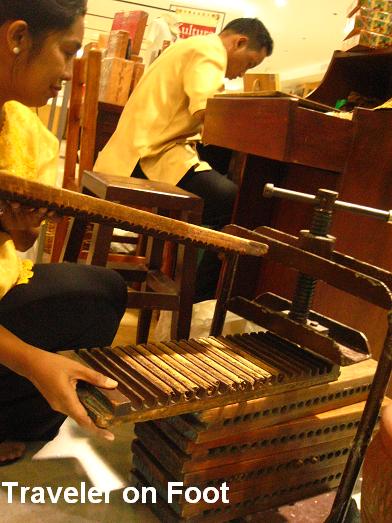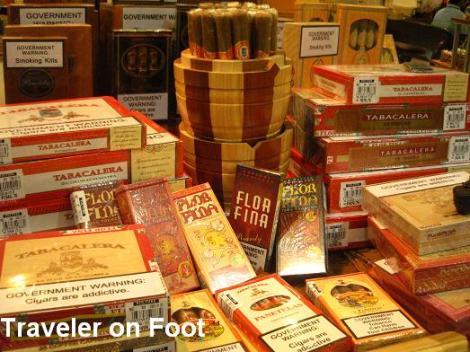
One thing I like about SM Malls lately is how they present Filipino products in an engaging way. The last time I was at the Kultura section at SM Department Store in North EDSA, tobacco-making is being demonstrated.
From the tobacco plantations, the leaves are fermented and aged for two years. After going through quality control procedures, they are places into varying classifications of wrapper, binder and filler. The classifications determine which blend would most suit the leaf.


Basic cigars are formed by wrapping filler tobacco in binder leaf. These are then placed in a mold that gives the cigar its shape. The molds are placed in a press overnight. The tobacco is then hand rolled into the cigar. The cigars are placed in an aging room to preserve and enhance the flavors.


Tobacco production became a stronghold of the Spanish colonial economy. It was towards the end of the 17th century when the Spanish galleon San Clemente brought to the country 200 ounces of Cuban tobacco seeds. These exquisite seeds were cultivated by the Spanish friars and flourished in the fertile region of Cagayan Valley, Isabela, a province in northern Luzon named after the Queen of Spain.

The Spanish administration became interested in all aspects of the production and trading of tobacco that it became a state monopoly in 1780. The tobacco monopoly, which was directed by the public Treasury, was a source of wealth in the 19th century.
In Manila, the Arroceros district was the home of the tobacco factory and warehouses, which provided jobs for 8,000 women and 1,500 men.

In 1881, the entire tobacco manufacturing industry in Manila became united and established the Compania General de Tabacos de Filipinas. This union gave rise to what is known today as La Flor de la Isabela, a name given in honor of the province where the first Cuban seeds were first cultivated and flourished.

La Flor de la Isabel holds the title of being the first and oldest cigar factory in Asia and one of the oldest cigar companies in the world. Tabacalera is its oldest and most popular brand. Called as the Manila Cigar, it is described by discriminating cigar connoisseurs world-wide for its mild, sweet, and very spicy taste.

I would lik to buy the cigars in the box and have it engraved where can i get it done. Thanks
ang galing nman ng picture…..hehehehe!wla me msbi ei sta ganda to……!
When I visited SM in Makati, Tabaqueria de Filipinas was conducting the demo and the salespeople were very helpful, answering all my questions. The blend of tobacco filler and wrapper is different depending on which brand you get — Antonio Gimenez is my favorite. When I am back in Germany, I order from the website http://www.tabaqueria.com. Here in Manila, I get the cigars at SM stores. You should be proud of your Philippine cigars. They are an enjoyable smoke!
Where can you purchase Tabacalera Largas cigars in the USA?
thank you for sharing this information arnold.
They taste better than cuban cigars – I’ve already bought a box of this cigars as a gift to some American friends and they all said it taste different, superior even, smoother than cubans.
We should promote this Filipino product more! good post!
—
The tobacco monopoly, the only monopoly in more than 300 yrs of Spanish rule was abolished because it became a corrupted franchise. Friars improved the crop making it viable enough to be traded and sold, they must have been smoking heavy then!
The tobacco monopoly was abolished because that was the norm in the US and this way American products could get into the Phillipines. In Europe (most of the countries, France, for instance), that followed the old tax system, tobacco was a kind of State monopoly -among other items- as a way for the State to get a revenue.
What is strange is that in Spain, that had several territories that produced tobacco and several tobacco factories at home, tobacco was a State monopoly -or rather a “renta estancada”, because of that, it was sold in special shops called estancos-.
What happens with monopolies is that prices tend to be higher, quality lower (still, la Flor de la Isabela was and is one of the finest cigars in the world), and it encourages smuggling. Free competition try to address those problems (sometimes it fails). But restricted monopolies in the time has been a normal way for Europeans to set up their companies ang get industrialised.
Great contribution. I appreciate it.
Yes estan. Which I think it’s great. the last time i was there embroidery is also being demonstrated.
so sm’s kultura is making these demos. i never knew that and really, its a wonderful showcase to highlight these.
I have no idea eric since I dont smoke. All I know is that the first tabacco seeds planted in the Philippnes are Cuban tabacco seeds.
Fascinating! I wonder how these local cigars taste compared to those from Cuba.